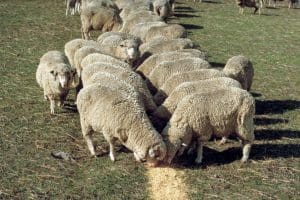
WA sheep producers have been warned to prepare to start supplementary feeding earlier than normal this year.
WESTERN Australian sheep producers are being urged to consider starting supplementary feeding earlier this year due to the reduction of pasture in paddocks.
The Department of Primary Industries and Regional Development is advising producers to monitor and condition score their sheep to help plan when to start supplementary feeding this summer.
The DPIRD advice comes as spring pasture growth has been reduced, after reduced rainfall during the growing season over much of the agricultural region.
DPIRD veterinary officer, Danny Roberts, said the amount of available feed on offer in dry pasture paddocks is reduced this year, prompting producers to consider supplementary feeding sheep earlier than normal.
“You would expect the amount of dry pasture in most paddocks to be greater than two tonnes per hectare by now but, despite late spring rainfall in some areas, the cumulative grazing pressure by sheep has restricted FOO levels.
“While one benchmark to commence supplementary feeding is less than 1500 kilograms of dry pasture per hectare, it is more effective for sheep producers to monitor the condition of their stock when they graze dry pastures,” Dr Roberts said.
Dr Roberts advised producers to monitor their flocks earlier, rather than later, to ensure ewes and weaners were on track and prepare to start supplementary feeding before they started to lose condition.
“As many producers have already joined or were about to join their ewes, it is important the sheep are condition score three or above so they are able to conceive and carry a lamb through pregnancy.
“It is also important to monitor the condition of weaned lambs to ensure they continue to maintain growth rates of one kilogram per month throughout summer and autumn,” he said.
He encouraged producers to prepare a feed budget to ensure they have sufficient amounts and types of feed to meet the needs of ewes and weaners, until at least six weeks after the break of the season next year.
“Ewes require sufficient energy to ensure they do not lose condition during joining,” Dr Roberts said.
“If FOO in dry pasture paddocks is below 1500 kilograms per hectare, then they will require some supplementation to ensure more than 90 per cent of ewes get pregnant.
“Weaners require energy and protein to continue to grow at a rate of one kilogram per month.”
Dr Roberts said to ensure weaner diets contain at least 14 percent crude protein, when less than 20 kilograms and 12pc above that weight, lupins or lupin-cereal mixtures or pellets were recommended.
He encouraged producers to monitor weaned lambs monthly, using condition scoring.
“However, weighing 50 weaners per mob will provide a more accurate guide but both monitoring methods are better than visual assessment, which will improve weaner survival during summer and autumn,” he said.
More information on feed budgeting and supplementary feeding strategies can be found in the booklet Feeding and Managing Sheep in Dry Times found at agric.wa.gov.au by searching for ‘dry season resources’
Source: DPIRD.

HAVE YOUR SAY